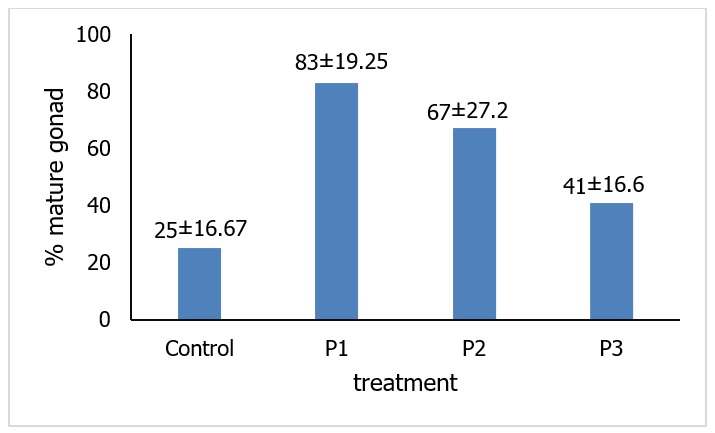Effect of different types of feed (squid, sea worms, and trash fish) to gonad maternity and fundamental levels of Galah shrimp (Macrobrachium Rosenbergii)
DOI:
https://doi.org/10.22219/ijota.v4i1.15850Keywords:
Fecudity, Galah, Giant Prawn, Gonad MaturityAbstract
Giant prawns (Macrobrachium rosenbergii) need enough nutrients for the reproductive process. One way to give feed which contains high enough protein. Complete nutritional content, especially protein, can be found in natural food. The type of natural feed used for main feeds including squid, sea worms, trash fish. Complete nutrient content can affect the rate of gonadal development and fecundity. (Squid, sea worms, trash fish) on the level of gonadal maturity and density of broodstock parents (Macrobrachium rosenbergii). This research was conducted by a completely randomized design (CRD) trial design. This study used 4 replications of different types of feeding. The types of feed given are squid, sea worms, trash fish, and pellets at a dose of 5% from biomass/day. The parameters of observation include observation of the level of gonad resistance, fundamentality of broodstock parent, and measurement of water quality (temperature, pH, and dissolved oxygen). The results showed that the administration of different types of feed (sea worms, trash fish) had a very significant effect on the level of maturity and had a significant effect on the probability of prawns (M. rosenbergii). After analysis of variance, the results of F Calculations are greater than F Table 0.05 and F Table 0.01. The smallest significant difference test (LSD) was obtained in P1 (Squid feed) with the Gonad maturity rate ± 5- 6 days as much as 83 % parent and fecundity average results of 28,846 ± 4,925.3 thousand / 45 g.
Downloads
References
Astawan. (2009). Estimation of Some Parameters of Population Dynamics of Squid of Moligo chinensis on New Waters of South Sulawesi. Makassar: Hasanuddin University.
Fisheries and Marine Service. (2006). Annual Report of the Fisheries and Marine Service. DI Province of Yogyakarta.
Irianti, D. S. A., Yustiati, A., & Hamdani, H. (2016). Survival and Growth of Giant Shrimp with Potatoes in Maintenance Media. Jurnal Perikanan dan Kelautan, 7(1): 23-29.
Elovaara, A. K. (2001). Shrimp Farming Manual. Practical Technology for Intensive Commercial Shrimp Production. United States of America, 2001. Chapter 4 p. 1 - 40.
Habibi. (2013). Feed Consumption and Efficiency of the Siamese Jambal Fish Feeded with Different Protein Energy Levels. Padjadjaran University.
Hartati. (2013). Fecundity and Egg Diameter of Stripped snakehead (channa striata bloch, 1793) in Tempe Lake, Wajo. Saintek Perikanan, 8(2): 18-24.
Haryati, Zainuddin, & Muchlis, S. (2010). Effect of giving various natural feed combinations on wind shrimp (Penaeus monodon) to reproductive potential and quality of larvae. Ocean Sciences. 15(3): 163 - 169.
Huang, J. H., Jiang, S. G., Lin, H. Z., Zhou, F. L., & Ye, L. (2008). Effects of dietary highly unsaturated fatty acids and astaxanthin on the fecundity and lipids content of ponded Penaeus monodon (Fabricius) Broodstock. Aquaculture, 39: 240 - 251.
Kordi. (2008). Effective Management of Economical Fisheries Ponds Management. Yogyakarta: Lily Publisher.
Moss, S. M., & Crocos, P. J. (2001). Global Shrimp OP: 2001 - Preliminary Report. Maturation Report. Glob. Aquac. Advocate, 4(4): 28 - 29.
Pure. 2004. Intensive Cultivation of Giant Prawns. Agromedia Library. Jakarta.
Pamungkas, W., Ikhsan, K. & Sri, R. R. P. (2007). Pengaruh vitamin C terhadap perkembangan gonad induk udang galah (Macrobrachium rosenbergii). Journal of Fisheries, 9(2): 194-199.
Wilson, M. A. (2011). A reproductive and feeding of tuna behavior of Skipjack (Katsuwonus Pelllmis) in Papua New Guinea Waters. Fisheries Research and Survey Branch Department of Primary Industry, Port Moresby.
Wouters, R., Lavens, P., Nieto, J., & Sorgeloos, P. (2001). Penaeid shrimp broodstock nutrition: an updated review on research and development. Aquaculture, 202(1-2): 1–21.
Yuwono, E. (2005). Crustacean nutrition needs and potential lur worms (Nereis, Polychaeta) for shrimp feed. Journal of Rural Development, 5(1): 42 - 49.

Downloads
Published
How to Cite
Issue
Section
License
Copyright (c) 2021 IJOTA (Indonesian Journal of Tropical Aquatic)

This work is licensed under a Creative Commons Attribution-ShareAlike 4.0 International License.
IJOTA (Indonesian Journal of Tropical Aquatic) allows readers to read, download, copy, distribute, print, search, or link to its articles' full texts and allows readers to use them for any other lawful purpose. The journal allows the author(s) to hold the copyright without restrictions. Finally, the journal allows the author(s) to retain publishing rights without restrictions
- Authors are allowed to archive their submitted article in an open access repository
- Authors are allowed to archive the final published article in an open access repository with an acknowledgment of its initial publication in this journal

